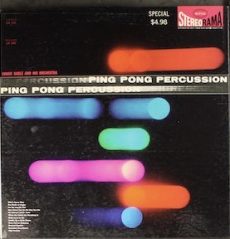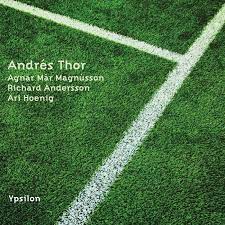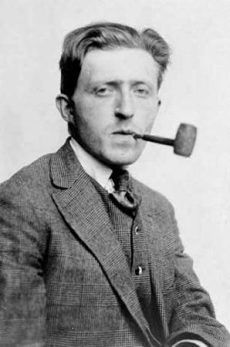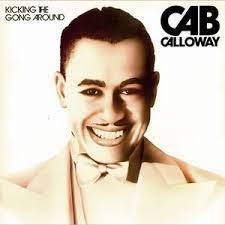
Daily Dose Of Jazz…
Al Klink was born on December 28, 1915 in Danbury, Connecticut. He began his professional career playing with Glenn Miller from 1939 to 1942 as a featured soloist, along with Tex Beneke, on the most well-known version of In the Mood. When Miller started playing in the U.S. military, he took a chair in Benny Goodman and Tommy Dorsey orchestras. He appeared in the 1941 film Sun Valley Serenade and 1942’s Orchestra Wives.
From 1952 to 1953 he played with the Sauter-Finegan Orchestra. Two years later he recorded his only session as a bandleader, performing six songs for a Bob Alexander album that won a Grammy Award. In the late 1960s to early Seventies, he was a tenor saxophone doubler on the staff of NBC’s Tonight Show Band under Doc Severinsen, where he was an occasional featured soloist.
He recorded with Mundell Lowe, Gerry Mulligan, Judy Holliday, Nelson Riddle, Phil Silvers, Cootie Williams and Rex Stewart. After a hiatus from recording and performing, he returned in 1974 when he began playing with the World’s Greatest Jazz Band. During the 1970s, he played with Glenn Zottola and George Masso, and continued playing until the mid-1980s, when he retired to Florida.
Swing tenor saxophonist Al Klink, who recorded ten albums as a sideman between 1956 and 1961, transitioned on March 7, 1991 at the age of 75 in Bradenton, Florida.
More Posts: history,instrumental,jazz,music,saxophone

Daily Dose Of Jazz…
Andrés Thor was born on December 27, 1974 in Hafnarfjordur, Iceland, a little harbour town near Reykjavík, Iceland. He began his musical studies at age 12 and his initial influences were glitter and hippie rock bands such as Led Zeppelin, The Doors, Jimi Hendrix and Bon Jovi.
During his teens was when he first heard the music of John Coltrane and Pat Metheny which led him to become more fascinated with jazz. He soon started studying with some of Iceland’s finest jazz educators at the FIH music school and after graduating his musical quest brought him to study at the Koninklijk Conservatorium (The Royal Conservatory) in The Hague, The Netherlands in 2000.
Finishing his Bachelors and Masters degrees by 2006 he went on to study under the guidance of Wim Bronnenberg, Peter Nieuwerf, Eef Albers, John Ruocco and Hein v/d Geyn as his main teachers. He also attended workshops and masterclasses lead by Michael Brecker, Kurt Rosenwinkel, John Abercrombie and Avishai Cohen, as well as performing with the late Michael Brecker and the Royal Conservatory Big Band in concert.
Living and studying in the Netherlands lead to the first recording featuring Andrés as a co-leader of the organ trio Wijnen, Winter & Thor. The band featured songs by all members of the trio. Since then he has been based and working in and out of Iceland and has released five albums under his own name and a handful of albums in collaboration. He has been active in various collective projects and as a sideman with bands like ASA trio, Icewegian, The Viking Giant Show, BonSom, Andreas Dreier quartet and Music with Z to name a few.
Thor has been an active performer in Scandinavia, Europe and America, as well as a session musician in studios and educator in Iceland. He doubles on the mandolin, banjo and steel guitars. Guitarist Andrés Thor continues to record and perform blending his positively ambrosial tonal palette with the elegant harmonic substance and incisive, ornamented cross-rhythms.
More Posts: banjo,guitar,history,instrumental,jazz,mandolin,music

Jazz Poems
BRINGING JAZZ (Odd-numbered lines spoken slowly even -numbered ones quickly) Last night I had an oboe dream— Whistlers in a box-car madness bringing jazz Their faces stormed in a hobo-gleam, Blinding all the grinding wheels and singing jazz. The box-car gloried in its dirt— Just as hallelujah made of chanting mud. And one old bum opened up his shirt Showing wounds of music in his ranting blood. The hoboes sang with scorching notes Burning up the pain into a gale of jazz, While sadness poured in their shaking throats, Like a molten bugle in a wail of jazz. The rails were jails for death and rust— Holding up the cruel, dark blue speed of jazz— But life still stirred underneath their crust— Little hums and clicks brought by the need of jazz. Within the box-car, hoboes leaped— Fatalists and pagan in a carefree trap— And when they sang of hungers reaped, Bread and wine of sound came from a dark god’s lap! The hoboes made a fox-trot blaze— Scorning women, gliding in a sexless dance— And on their coats of ragged baize- Ghosts of orchids fluttered down and looked askance! The jungle sent a moan of sound—- Made it blend into an oathof northern grime. A music came, flaring and profound, Flayed with rapture half repelled and half sublime. And then I saw the dream’s dark spring—- Hurricanes of jazz born from the underworld. “Saint Louie Gal with a diamond ring” Danced with mobs of hoboes while the thunder swirled! MAXWELL BODENHEIMfrom Jazz Poems | Selected and edited by Kevin Young
More Posts: book,classic,collectible,history,jazz,library,poet

Daily Dose Of Jazz…
Rupert Theophilus Nurse was born the only child in Port of Spain, Trinidad on December 26, 1910. He spent some of his childhood in Venezuela before returning to the island to complete his education. He absorbed local calypso music traditions, and started working as a teacher in Tobago.
He taught himself piano, and learned arranging skills from a mail order Glenn Miller book, before returning around 1936 to Trinidad where he worked in an electronics business. He also learned to play the tenor saxophone and with Guyanese saxophonist Wally Stewart, formed the Moderneers or Modernaires, the first American-style big band in Trinidad. During the Second World War he played with visiting Americans on the island, and began writing jazz arrangements of calypsos.
Travelling to London, England in 1945, he began playing double bass with guitarist Fitzroy Coleman and pianist Cyril Jones in the Antilles jazz club near Leicester Square. He joined trumpeter Leslie “Jiver” Hutchinson’s mostly-black band, with whom he played on radio and toured in Europe, before working with entertainer Cab Kaye in the Netherlands. He also increasingly worked with musicians newly arriving in Britain from the West Indies, including popular pianist Winifred Atwell, and Lord Kitchener and his band. He began experimenting with electronic instruments along with Lauderic Caton.
By 1953, Nurse was appointed as musical director of the Melodisc record label, which increasingly sought to release records to appeal to Britain’s growing Afro-Caribbean community. He led the label’s house band, arranged and produced Kitchener’s recordings, and recorded many other musicians of Caribbean origin, including jazz saxophonist Joe Harriott. He continued to perform as a pianist, and became bandleader at the Sunset Club in Carnaby Street and then at the more upscale Sugar Hill club in St James’s, where he met and later recorded with pianist Mary Lou Williams.
He increasingly used an electric piano and organ, and worked widely in clubs and restaurants in London as a solo performer and with other musicians including steel pan player Hugo Gunning, bassist Coleridge Goode, and pianists Iggy Quail and Russ Henderson. He taught, devised arrangements for other musicians, and worked as a library cataloguer in London until 1976.
Retiring to Arima, Trinidad he continued to mentor musicians and write arrangements for them. Pianist, tenor saxophonist and double bassist Rupert Nurse, who was influential in developing jazz and Caribbean music in Britain, particularly in the 1950s, transitioned there on March 18, 2001 at the age of 90.
More Posts: bandleader,bass,history,instrumental,jazz,music,piano,saxophone

Daily Dose Of Jazz…
Cabell Calloway III was born on December 25, 1907 in Rochester, New York, on December 25, 1907 to two college graduates, his mother a teacher and church organist, and his father who worked as a lawyer and in real estate. The family moved to Baltimore, Maryland, in 1919 but soon after, his father died and his mother remarried.
Growing up in West Baltimore’s Druid Hill neighborhood Cab often skipped school to earn money by selling newspapers, shining shoes, and cooling down horses at the Pimlico racetrack where he developed an interest in racing and gambling on horse races. He ended up in Downingtown Industrial and Agricultural School, a Pennsylvania reform school run by his mother’s uncle.
Returning to Baltimore he resumed hustling, worked as a caterer while he improved his studies in school, and his mentors included drummer Chick Webb and pianist Johnny Jones. After graduating high school Calloway joined his older sister Blanche on tour for the popular black musical revue Plantation Days. He spent most of his nights in Chicago, Illinois clubs performing as a singer, drummer, master of ceremonies and as an understudy for singer Adelaide Hall. There he met and performed with Louis Armstrong, who taught him to sing in the scat style.
He established himself as a vocalist singing Ain’t Misbehavin’ by Fats Waller. The Thirties saw Cab’s orchestra permanently at the Cotton Club in Harlem, performed twice a week for radio broadcasts on NBC, and appeared on radio programs with Walter Winchell and Bing Crosby. He was the first Black American to have a nationally syndicated radio show and during the depths of the Great Depression he was earning $50,000 a year at 23 years old.
During the decade he recorded his most famous song, Minnie the Moocher, and became the first single record by a Black American to sell a million copies. He performed the song along with St. James Infirmary Blues and The Old Man of the Mountain, in Betty Boop cartoons of the same name.
His success with Minnie the Moocher and his relationship to the chorus earned him the nickname, The Hi De Ho Man. He performed a gliding backstep dance move called The Buzz, which some observers have described as the precursor to Michael Jackson’s moonwalk. He would go on to be featured in several films, and made his first Hollywood feature film appearance opposite Al Jolson in The Singing Kid in 1936.
His band included Ben Webster, Illinois Jacquet, Milt Hinton, Danny Barker, Doc Cheatham, Ed Swayze, Cozy Cole, Eddie Barefield, and Dizzy Gillespie. He entertained troops during World War II, hosted a weekly radio quiz show called The Cab Calloway Quizzicale and recorded songs full of social commentary. He appeared in the film Stormy Weather, one of the first mainstream Hollywood films with a black cast. Then he played the prominent role of Sportin’ Life in a stage production of Porgy and Bess. He continued to perform in movies and on stage throughout his career.
He published an autobiography and Cab Calloway’s Cat-ologue: A “Hepster’s” Dictionary, the first dictionary published by a Black American. It became the official jive language reference book of the New York Public Library.
Suffering a stroke at his home, vocalist, bandleader and actor Cab Calloway transitioned from pneumonia on November 18, 1994, at the age of 86, at a nursing home in Hockessin, Delaware.
More Posts: actor,bandleader,history,instrumental,jazz,music,vocal



